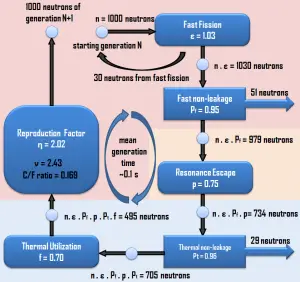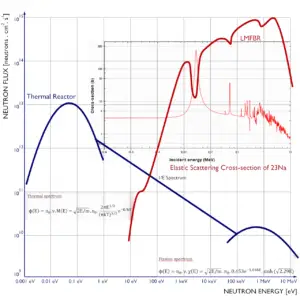The neutron life cycle quantifies the most important neutron-physical processes that occur in the nuclear reactor. In the reactor, neutrons are produced as fast neutrons and most of them are absorbed after thermalization. There are six processes (factors) that describe the inherent multiplication ability of the system. Four of them are completely independent of the size and shape of the reactor and these are:
 Fast Fission. The fast fission process is in the multiplication factor characterized by the fast fission factor, ε, which increases the fast neutron population in one neutron generation. The fast fission factor is defined as the ratio of the fast neutrons produced by fissions at all energies to the number of fast neutrons produced in thermal fission.
Fast Fission. The fast fission process is in the multiplication factor characterized by the fast fission factor, ε, which increases the fast neutron population in one neutron generation. The fast fission factor is defined as the ratio of the fast neutrons produced by fissions at all energies to the number of fast neutrons produced in thermal fission.- Resonance Escape. The resonance escape probability, symbolized by p, is the probability that a neutron will be slowed to thermal energy and will escape resonance capture. This probability is defined as the ratio of the number of neutrons that reach thermal energies to the number of fast neutrons that start to slow down.
- Thermal Utilization. The thermal utilisation factor, f, is the fraction of the thermal neutrons that are absorbed in the nuclear fuel, in all isotopes of the nuclear fuel. It describes how effectively (how well are utilized) are thermal neutrons absorbed in the fuel. The value of the thermal utilization factor is given by the ratio of the number of thermal neutrons absorbed in the fuel (all nuclides) to the number of thermal neutrons absorbed in all the material that makes up the core.
- Reproduction. The number of neutrons created in the new generation is determined by the neutron reproduction factor. The reproduction factor, η, is defined as the ratio of the number of fast neutrons produced by thermal fission to the numberof thermal neutrons absorbed in the fuel.
These processes of neutron life cycle, quantified by their factors, constitute the infinite multiplication factor (k∞), which may be expressed mathematically in terms of these factors by following equation, usually known as the four factor formula:
k∞ = η.ε.p.f
The effective multiplication factor (keff) may be expressed mathematically in terms of the infinite multiplication factor (k∞) and two additional factors which account for neutron leakage during neutron thermalisation (fast non-leakage probability) and neutron leakage during neutron diffusion (thermal non-leakage probability) by following equation, usually known as the six factor formula:
keff = k∞ . Pf . Pt
- Fast Non-leakage Probability. During the slowing down process, some of the neutrons leak out of the boundaries of the reactor core before they become thermalized. This process and its impact on the effective multiplying factor is characterized by the fast non-leakage factor, Pf, which is defined as the ratio of the number of fast neutrons that do not leak from the reactor core during the slowing down process to the number of fast neutrons produced by fissions at all energies.
- Thermal Non-leakage Probability. During the neutron diffusion, some of the neutrons leak out of the boundaries of the reactor core before they are absorbed. This process and its impact on the effective multiplying factor is characterized by the thermal non-leakage factor, Pt, which is defined as the ratio of the number of thermal neutrons that do not leak from the reactor core during the neutron diffusion process to the number of neutrons that reach thermal energies.
In reactor physics, keff is the most significant parameter with regard to reactor control. At any specific power level or condition of the reactor, keff is kept as near to the value of 1.0 as possible. At this point in operation, the neutron balance is kept to exactly one neutron completing the life cycle for each original neutron absorbed in the fuel.
Neutron Life Cycle in Fast Reactors

The method of calculations of multiplication factors has been developed in the early years of nuclear energy and is only applicable to thermal reactors, where the bulk of fission reactions occurs at thermal energies. This method well puts into the context all the processes, that are associated with the thermal reactors (e.g. the neutron thermalisation, the neutron diffusion or the fast fission), because the most important neutron-physical processes occur in energy regions that can be clearly separated from each other. In short, the calculation of multiplication factor gives a good insight in the processes that occur in each thermal multiplying system.
For fast reactors, in which the fission are caused by neutrons with a very broad energy distribution, such an analysis is inappropriate. The neutron flux in fast reactors have to be divided into many energy groups. Moreover, in fast reactors, the neutron thermalisation is undesirable process and therefore the four factor formula does not really make any sense. The resonance escape probability is not significant because very few neutrons exist at energies where resonance absorption is significant. The thermal non-leakage probability does not exist because the reactor is designed to avoid the thermalization of neutrons.
We hope, this article, Neutron Life Cycle, helps you. If so, give us a like in the sidebar. Main purpose of this website is to help the public to learn some interesting and important information about radiation and dosimeters.